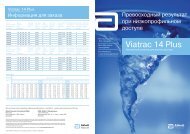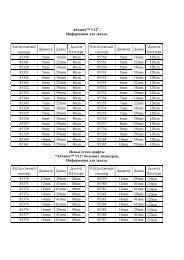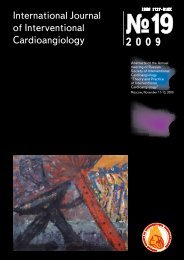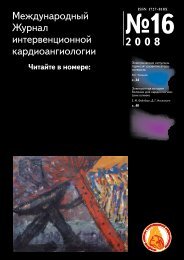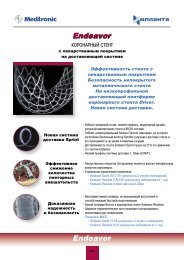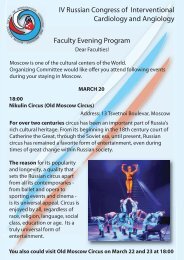Results of Coronary Stenting using the Stents with
Results of Coronary Stenting using the Stents with
Results of Coronary Stenting using the Stents with
You also want an ePaper? Increase the reach of your titles
YUMPU automatically turns print PDFs into web optimized ePapers that Google loves.
Interventional cardiology<br />
Comparative Effectiveness <strong>of</strong> Conservative and Invasive<br />
Treatment <strong>of</strong> Myocardial Infarction in Elderly and Old<br />
Patients<br />
A.B. Shames 1 , V.A. Ivanov<br />
A.A. Vishnevsky 3rd Central Military Clinical Hospital, Krasnogorsk, Russia<br />
Old age is one <strong>of</strong> <strong>the</strong> most important factors influencing <strong>the</strong> outcome <strong>of</strong> myocardial infarction (MI). According<br />
to several studies, over 50% <strong>of</strong> MI-related deaths occur in patients over 75 years old. The authors performed a<br />
comparative analysis <strong>of</strong> <strong>the</strong> effectiveness <strong>of</strong> conservative and invasive treatment in 656 patients <strong>with</strong> MI aged<br />
from 60 to > 90 years. It was found that emergency invasive tactics is a method <strong>of</strong> choice for <strong>the</strong> treatment <strong>of</strong><br />
MI in high-risk patients, <strong>the</strong> majority <strong>of</strong> whom are elderly and old patients.<br />
Keywords: myocardial infarction, elderly and old patients, invasive tactics.<br />
Introduction<br />
The 20th century has been marked by demographic<br />
aging <strong>of</strong> population in <strong>the</strong> industrial countries —<br />
<strong>the</strong> redistribution <strong>of</strong> age structure <strong>of</strong> population <strong>with</strong><br />
<strong>the</strong> increase <strong>of</strong> <strong>the</strong> share <strong>of</strong> elderly and old people.<br />
According to <strong>the</strong> prognoses made by American researchers,<br />
by 2025 <strong>the</strong>re will by over 1 billion <strong>of</strong> people<br />
over 60 in <strong>the</strong> world population (1). The increase<br />
<strong>of</strong> <strong>the</strong> number <strong>of</strong> older age groups is a challenge for<br />
modern medicine. It is related to <strong>the</strong> particularities<br />
<strong>of</strong> elderly and old age (involutional changes in <strong>the</strong><br />
organism, polymorbidity, atypical course <strong>of</strong> <strong>the</strong> diseases,<br />
changes in social and psychological status),<br />
as such patients, as a rule, are at high risk <strong>of</strong> death.<br />
For this reason <strong>the</strong> choice <strong>of</strong> <strong>the</strong> method <strong>of</strong> treatment<br />
should be made <strong>with</strong> caution and based on <strong>the</strong><br />
“risk / benefit” ratio.<br />
Elderly and old age <strong>of</strong> patients is one <strong>of</strong> <strong>the</strong> most<br />
important risk factors influencing <strong>the</strong> outcome in<br />
myocardial infarction (MI). According to several authors,<br />
over 50% <strong>of</strong> death from MI occur in patients<br />
over 75 years old (1-3).<br />
Purpose <strong>of</strong> study<br />
To compare <strong>the</strong> effectiveness <strong>of</strong> conservative and<br />
invasive treatment <strong>of</strong> MI in elderly and old age.<br />
Material and methods<br />
We have compared <strong>the</strong> effectiveness <strong>of</strong> conservative<br />
and invasive treatment in 656 patients <strong>with</strong> MI.<br />
The patients have been assigned to age groups in<br />
accordance <strong>with</strong> <strong>the</strong> classification <strong>of</strong> <strong>the</strong> periods <strong>of</strong><br />
aging and old age <strong>of</strong> <strong>the</strong> European regional bureau<br />
<strong>of</strong> <strong>the</strong> World Health Organization (WHO) (4). At first<br />
admission clinical characteristics <strong>of</strong> patients <strong>with</strong> MI<br />
1<br />
Address for correspondence:<br />
Dr. A. Shames<br />
Russia, 143420, Moscow region, Krasnogorsk district.,<br />
PO Arkhangelskoye, township Novy.<br />
A.A. Vishnevsky 3rd Central Military Clinical Hospital»<br />
Tel. 007 495 564-63-81.<br />
E-mail: ashames@yandex.ru<br />
Manuscript received on June 03, 2011.<br />
Accepted for publication on September 21, 2011<br />
have been determined <strong>with</strong> <strong>the</strong> use <strong>of</strong> <strong>the</strong> classification<br />
suggested by <strong>the</strong> All-Union Cardiological Scientific<br />
Center <strong>of</strong> <strong>the</strong> Academy <strong>of</strong> Medical Sciences<br />
<strong>of</strong> <strong>the</strong> USSR (1984), developed on <strong>the</strong> base <strong>of</strong> WHO<br />
expert guidelines (5).<br />
370 patients were aged from 60 to 74 years, 284 —<br />
from 75 to 89 years, and <strong>the</strong>re were 2 patients aged<br />
90 and more. Non ST-elevation MI (nSTEMI) was diagnosed<br />
in 344 patients, while 312 had ST-elevation<br />
MI (STEMI). In 48,6% <strong>of</strong> cases MI involved <strong>the</strong> anterior<br />
left ventricular wall, in 43,5% — <strong>the</strong> inferior/posterior<br />
wall, in 7,9% <strong>of</strong> cases it had ano<strong>the</strong>r localization.<br />
Primary MI was diagnosed in 449 (68,4%) patients:<br />
nSTEMI in 203 (30,9%), and STEMI in 246 (37,5%).<br />
207 patients (31,6%) had repeated MI: nSTEMI in<br />
141 (21,5%), and STEMI in 66 (10,1%). 16% <strong>of</strong> all patients<br />
were women. Comorbidities included: arterial<br />
hypertension in 73,8% <strong>of</strong> patients, diabetes mellitus<br />
in 20%, signs <strong>of</strong> chronic heart failure in 49,6%, signs<br />
<strong>of</strong> chronic renal failure in 3,1%; 6,7% <strong>of</strong> patients had<br />
a history <strong>of</strong> surgical myocardial revascularization.<br />
Conservative treatment in conformity <strong>with</strong> national<br />
and international guidelines for <strong>the</strong> treatment<br />
<strong>of</strong> MI (6-9) was applied in 530 cases. 48,3% <strong>of</strong> patients<br />
were in <strong>the</strong> elderly age group (60-74 years),<br />
51,7% — in <strong>the</strong> old age group (75-89 years). Primary<br />
MI was diagnosed in 369 patients (166 — nSTEMI,<br />
203 — STEMI), repeated MI — in 161 patients (113 —<br />
nSTEMI, 48 — STEMI).<br />
Invasive treatment (coronary angioplasty <strong>with</strong><br />
stenting) was applied in 126 cases — among <strong>the</strong>m<br />
91% from <strong>the</strong> elderly and 9% from <strong>the</strong> old age group.<br />
Among <strong>the</strong>se patients 65 had nSTEMI and 61 had<br />
STEMI. Primary MI was diagnosed in 80 (63,5%)<br />
patients: nSTEMI — 29,4%, STEMI — 34,1%; repeated<br />
MI — in 46 (36,5%): nSTEMI –22,2%, STEMI–<br />
14,3%. <strong>Coronary</strong> angiography revealed significant<br />
(>79%) single vessel disease in 19,5% <strong>of</strong> patients,<br />
two-vessel disease in 32,5%, three-vessel disease —<br />
in 43,9% <strong>of</strong> patients; isolated lesion <strong>of</strong> <strong>the</strong> left main<br />
coronary artery was found in 4,1% <strong>of</strong> patients. In<br />
41% <strong>of</strong> cases occlusive and stenotic lesions involved<br />
<strong>the</strong> LAD, in 31,4% — <strong>the</strong> right CA, in 26,8% — <strong>the</strong><br />
22<br />
(№ 26, 2011)




